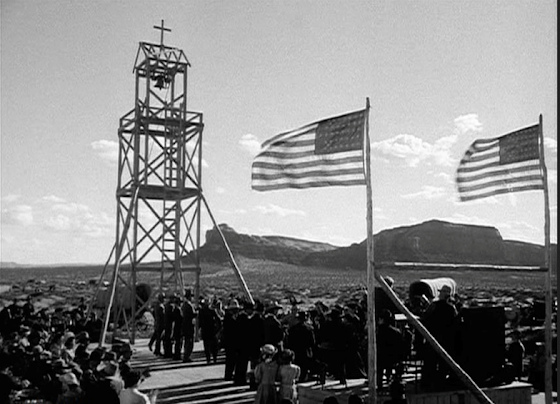My Darling Clementine (1946)
John Ford’s ‘My Darling Clementine’
Thematic Elements: My Darling Clementine is John Ford’s first movie back from the World War II. It takes place in a town called, ‘Tombstone.’ The name itself seems ominous and suggests a town of violence and disorder. The movie is in essence a reenactment of the central morality play of the Western. Wyatt comes into town and recognizes the disorder and wants to take it upon himself to instill more order. It seems in this way the town is representative of the negative effects of the west, and what people are capable of given no law or order. So really, the real showdown of the movie comes between law and anarchy, Wyatt Earp representative of law and order made even more clear with him being a literal lawyer. Law wins in the end and signifies the arrival of civilization. Clementine, the movie’s namesake, also seems to represent the impending civilization of the untamed west. She is Doc Holliday’s former partner who has come to town to collect him. Doc is suffering from a terminal illness and has escaped to this town to escape society and be free to act in lawlessness as he sulks and drinks himself into a coma. It seems this remembrance of civilization has pushed Doc more and more away, wanting only to live unabashedly with his choices. However, Wyatt has taken to this ideal of the eventual modernization of society as he grows close to Clementine. It seems that after the violent and stressful war, John Ford’s views of the modern Western seem to be that lawlessness and violence will reign unless societies of law and order are instituted. The town in which anyone can pull their gun out and start shooting at any time could very well resemble the uncertainty of wartime. It seems that Ford’s viewpoint seems to favor the control of this environment, in which the blank slate of the west cannot continue to function without the implementation of modernized society.
Camerawork: Although the film takes place in a town of lawlessness, Ford suppresses the scenes of violence. Ford seems to spend more time focusing on scenes that meditate on the joie de vivre of modern society. This helps enforce his views on modernization. He spends more time focusing on the tender moments, moments that can only be possible with the elimination of fear and chaos. These moments reflect on the celebration of life, faith, and community.
Best Shot: One of these scenes of the celebration of
life, faith, and community comes when Wyatt and Clementine dance at church
service whilst the church is still under construction. This scene best
illustrates the community coming together to share in the comforts of modernization
and the construction of a stable society.




Comments
Post a Comment